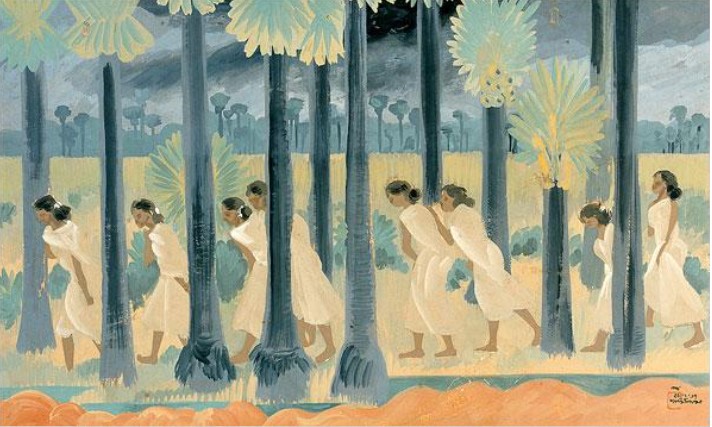Background
The Nineteenth Century is considered a golden era in Bengal’s history. Significant transitions were taking place in Indian society, notably in Bengal, throughout the early decades of the nineteenth century. In a nutshell, these changes were referred to as the ‘Bengal Renaissance’. The concept of the ‘Bengal Renaissance’ signified an episode of rebirth, awakening, or rejuvenation of society and culture. This ‘awakening’ certainly was influenced by Western education and culture inculcated in India due to colonial rule. Western culture influenced modernism in both Bengal and India. Self-awareness, political consciousness, a new social class structure as a result of a rising economy, and, most crucially, a changing lifestyle all had an impact on Bengal’s traditional social institutions in Colonial India. In this scenario, the Western influence posed a substantial threat to the whole social and cultural fabric of the country. The new generation of artists and intellectuals had questions about their roots and origins that needed to be answered. Thus, the Bengal Renaissance was an important turning point in Indian history for its cultural, intellectual, and social movement that had a significant impact on the advancement of the country. This article examines the impact of the Bengal Renaissance on development in a wide range of sectors, with a particular focus on its impact on the arts and culture in the Bengal region prior to partition, which has culminated in a shared cultural heritage between Bangladesh and the Indian state of West Bengal.
Contributions of Bengal Renaissance in various sectors
The Bengal Renaissance, a period in the nineteenth century, heralded modernization in many fields, including literature, religion, social change, political views, and scientific discoveries. At the time, Bengal was a part of undivided India under British administration, with Raja Ram Mohan Roy as its religious, educational, and social reformer. Roy founded the ‘Brahmo Sabha’ in 1828 with Dwarkanath Tagore, which subsequently became the sociological component of ‘Brahmo religion’ known as ‘Brahmo Samaj’.The intellectual awakening that arose from the Bengal Renaissance is sometimes linked to the 16th-century European Renaissance, however, Europe did not encounter the hardships of colonialism. It also witnessed the development of the ‘Young Bengals’, one of the region’s first-ever social groups, which promoted atheism and rationalism in order to level the caste system.
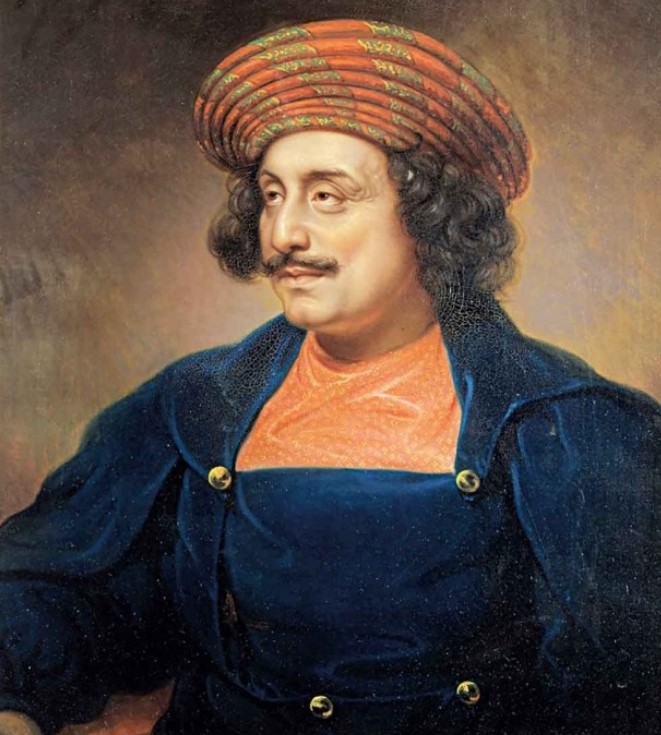 Portrait of Raja Ram Mohan Roy, 1833, https://commons.wikimedia.org/
Portrait of Raja Ram Mohan Roy, 1833, https://commons.wikimedia.org/
Social reformers such as Raja Ram Mohan Roy and Ishwar Chandra Vidyasagar fought for women’s education, widow remarriage, and the removal of restrictive customs such as sati during the Bengal Renaissance. Swami Vivekananda, a spiritual leader and philosopher, advocated for religious tolerance and global unity. Dwarkanath Tagore and Akshay Kumar Datta advocated for contemporary education and scientific thought, which resulted in the development of schools and universities. Leaders such as Surendranath Banerjee and Bipin Chandra Pal advocated for self-governance and independence from British authority. Dwijendranath Tagore and Rani Rashmoni were both involved in philanthropy and social welfare activities, with Rani Rashmoni’s contributions to religious and educational institutions having a long-lasting influence on society.
The Bengal Renaissance marked a cultural resurgence in India, embracing new ideas while appreciating its rich tradition. With their lyrical brilliance and social insight, prominent literary personalities such as Rabindranath Tagore, Bankim Chandra Chattopadhyay, and Sarat Chandra Chattopadhyay revolutionized Indian literature. In 1913, Rabindranath Tagore’s Nobel Prize-winning masterpiece “Gitanjali” gained Indian literature international acclaim. The Bengal Renaissance’s adventurous spirit spurred intellectuals and scholars to travel to diverse civilizations and locations. Their travels and documents contributed to India’s greater awareness of the world. The Bengal Renaissance’s emphasis on nationalism and self-government aided India’s ultimate independence movement. Many of its notable figures were active participants in the liberation movement. During this period, Bengali physicist, biologist, archaeologist, botanist, and science fiction writer Jagadish Chandra Bose made groundbreaking contributions to science. Satyendra Nath Bose, Meghnad Saha, and Upendranath Brahmachari were among the other famous Bengali and Indian scientists of the time.
The focus of the movement on education and intellectual growth established the groundwork for modern education in India. The construction of educational institutions and libraries increased the intellectual riches of the country. The Tagore family, who were particularly concerned with educational reform, played an important role in the Renaissance. The ‘Bengal School,’ which started mostly in Calcutta and Santiniketan, promoted a uniquely Indian modernism that flourished throughout India during the British Raj in the early twentieth century. Folk art, Indian painting traditions, Hindu imagery, indigenous materials, and images depicting contemporary rural life were all included in the Bengal School style of paintings. The Bengal School artists promoted humanism and gave a powerful voice to Indian identity, independence, and liberty.
Military practices in India were refined during the Bengal Renaissance, with leaders such as Subhas Chandra Bose advocating for a disciplined force. Figures such as Dadabhai Naoroji and Keshub Chunder Sen shaped India’s political and intellectual landscapes. The Indian National Congress was led by Dadabhai Naoroji, regarded as the “Grand Old Man of India,” who fought for economic reform, while Keshub Chunder Sen sought to bridge the gap between Eastern and Western ideals. The Bengal Renaissance was a thrilling period in Bengali history, with contributions from forward-thinking and ambitious individuals helping future generations.
The Major Trends in the Bengal Renaissance
As mentioned in the research by Anandita Mondal (2020), the Bengal Renaissance can be classified into three major trends :
- Westophilia: This approach centred on Western ideals and achievements in science, technology, and culture, with social change serving as the primary means. It emphasized liberal thought and covered social reform, education, justice, civil society, the legal state, the national economy, science, and cultural development. Derozians/Young Bengal, Ishwarchandra Vidyasagar, Akshay Kumar Dutta, Kesubchandra Sen, and Sivanath Sastri were the prominent champions of this tendency, who wanted to dismiss traditional and indigenous values.
- Conservative: The conservative project emphasized traditional beliefs, traditions, and institutions, with a belief in the national spirit and India’s message to the modern world. It contended that traditional Hindu religion had elements of Western culture. Shashadhar Tarkachuramani, Krishnaprassana Sen, Radhakanta Dev, Bhhabanicharan Bandyopadhaya, and Ramkamal Sen were key figures in this endeavour. Shashadhar claimed that Darwin’s idea was discovered in Patanjali’s sutras, however, Krishnaprasanna argued that modern science was superior during the Ramayana period.
- Indo-Western Synthesis: The third variation blends India and the West by combining positive results from Western invention with positive achievements from Indian tradition. This school’s representatives were Bankim Chandra Chattopadhyay, Swami Vivekananda, Bhudev Mukhopadhyay, and Rabindranath Tagore, who evaluated Indian achievements fairly, avoiding mindless imitation or absorbing everything Indian.
Together, these three trends or ideologies in the Bengal Renaissance resulted in significant change and development in the educational, cultural and social sectors in the Bengal region of undivided India.
Influence of Bengal Renaissance on Art in Bengal/Bangladesh
The Bengal Renaissance brought about a revolution in the field of art and culture which led to a more modernist approach towards creating and perceiving artworks. In 1907, Gaganendranath Tagore and Abanindranath Tagore established ‘the Indian Society of Oriental Art’ in Calcutta, which was instrumental in organizing art-related programmes such as exhibitions, symposiums, discussion groups, paper reading and journal publications, which contributed majorly to sustaining the art related trends and documentation of artistic practices.
The Bengal Renaissance had a significant effect on art in West Bengal/Bangladesh. Following are the defining features of Bengal paintings influenced by the trends in Bengal Renaissance,
- Linear perspective: An advanced and highly sensible linear perspective was a significant element of the Bengal Renaissance paintings.
- Relationship between art and critique: A deep connection of art and criticism which was further enriched by the advancement in technique and mechanics of the West during the Bengal Renaissance.
- Microscopic delicacy: The first impression of the Bengal artists’ work ranged from microscopic delicacy to largeness and vigour. This image, however, was influenced partially by the Renaissance movement which developed the realization of something deeper and subtler than the art itself.
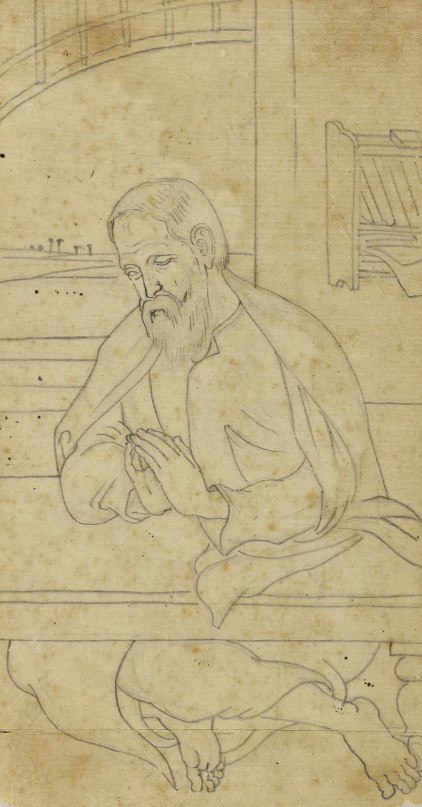 Nandalal Bose, Untitled, Preparatory Sketch Of Charles Freer Andrews, Https://Www.Sothebys.Com/
Nandalal Bose, Untitled, Preparatory Sketch Of Charles Freer Andrews, Https://Www.Sothebys.Com/
- Attachment to nature and humanity: The work of the Bengal artists demonstrated their attachment to nature which evolved significantly through time. The Bengal School of Painting also concentrated on close interaction with nature and humanity, which challenged the Bengal School’s inner vision of emotional and spiritual exploration.
- Coexistence of the realistic and impressionistic: Fusion became popular, but it did not imply an inharmonious method or style overlay. Instead, two major representation styles were born, ‘The realistic’ goal was to depict things as they were seen, whereas ‘the impressionistic’ goal was to communicate attributes through what was seen. By acknowledging the essential interaction of the visual and interpretive abilities, the Bengal school of painting was able to accomplish the principles of both realism and impressionism. They exhibited traits that were not emotionally charged but did not detract from the embodiment through which the emotion was expressed. They recognized the restrictions of form and colour in order to articulate that which is beyond shape and size, but they did not break the picture in order to unleash its spirit.
- Painter’s Individuality: The painters’ ‘psychological individuality’ had been another notable element evident in Bengal paintings throughout the Renaissance period.
The Ideology and Artists of Bengal School
The Bengal School functioned as an important artistic movement during the Bengal Renaissance, which emerged in the 20th century in Eastern India including present-day West Bengal and Bangladesh. Born out of the ‘Swadeshi’ movement, The Bengal School was an artistic revolt to boycott Western style of painting techniques and embrace the ancient Indian painting styles.
The Bengal School artists discarded British or Western literature and visual arts and produced works that had uniquely Indian qualities representing Hindu themes and Indian culture. The Bengal School was a form of resistance that gave rise to Indian nationalism. Traditional Indian painting techniques went out of favour during the British Raj due to their lack of appeal to British collectors. Indian subjects of indigenous plant life or traditional attire and ceremonies were pushed alongside European techniques and subjects in Company Paintings. Instead of appreciating Indian cultural traditions, it reduced them to exotica. To counteract such imagery, the Bengal School turned to Mughal influences, Rajasthani and Pahari styles, and portrayed exquisite scenes of authentically Indian traditions and daily life.
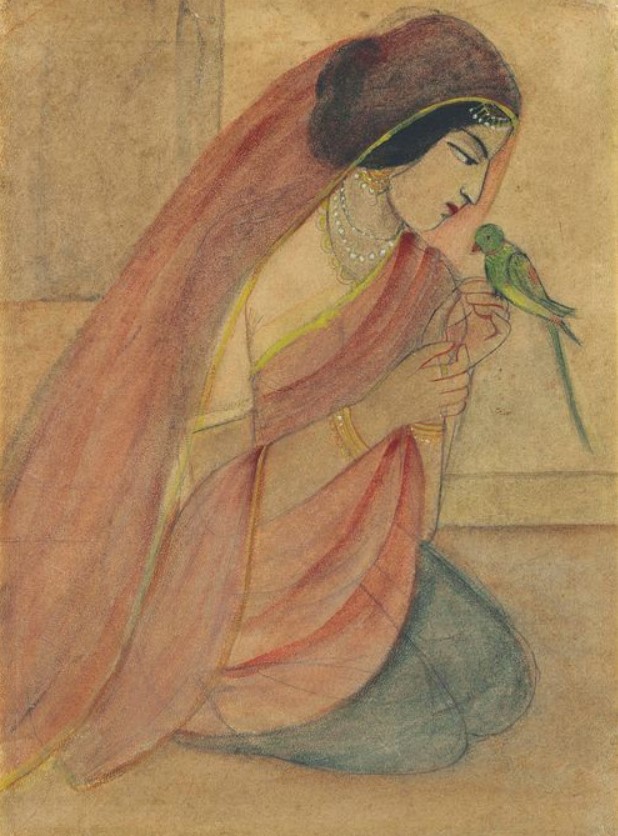 Painting by Sunayani Devi, https://prinseps.com/
Painting by Sunayani Devi, https://prinseps.com/
Ernest Binfield Havell, an English art historian and teacher, is regarded as an important founding member of the Bengal School, having encouraged students to refer to Mughal miniatures and assisting artists such as Abanindranath Tagore and his sister Sunayani Devi in developing the core principles and style of the movement and spreading it through educational systems. Havell was one of the pioneering contemporary British supporters of the Bengal School. Nandalal Bose, a prominent Bengal School artist, moved to Swadeshi principles to create distinctive Indian Modern Art. He was inspired by Ajanta murals and Indian mythology, and he became friends with Gandhi in the 1920s and 1930s. Bose’s sketches of Gandhi, honouring his Dandi March in 1930, employed expressive line work to show him as a humble yet strong hero, helping to shape twentieth-century Indian modernism, identity, and nationalism. From 1909 to 1911, Asit Kumar Haldar, a notable Bengal Renaissance artist who studied under Jadu Pal and Bakkeswar Pal, collaborated with Nandalal Bose to chronicle the Ajanta cave paintings and frescoes. In 1934, he was awarded a Fellow of the Royal Society of Arts in London for his work combining Buddhist art with Indian history. In addition to his artistic output and poetry, Haldar, like his fellow Bengal Art School painters, dedicated his life to social changes and educational programmes that would foster a sense of Indian nationalism in generations to come.
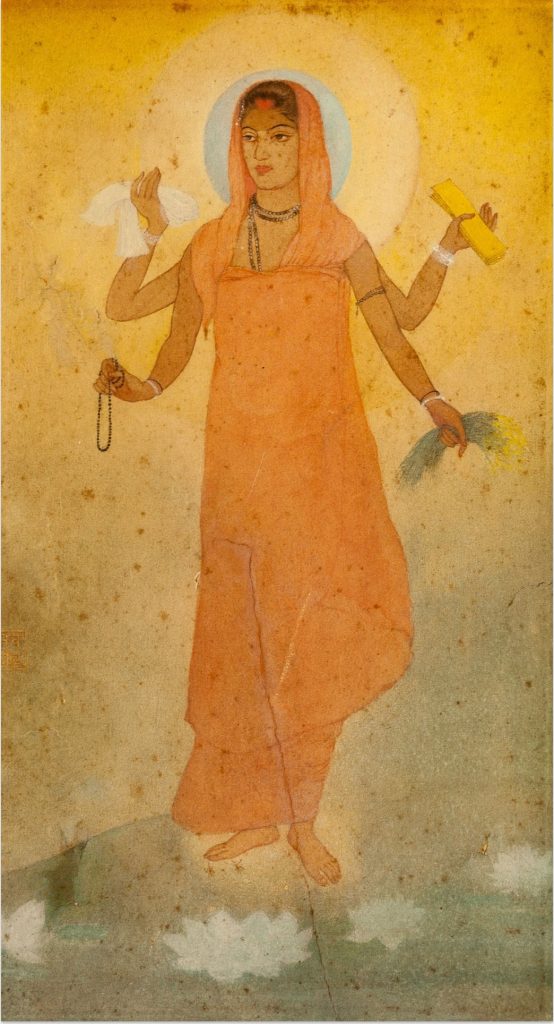 Bharat Mata (1905), by Abanindranath Tagore, a nephew of the poet Rabindranath Tagore, and a pioneer of the movement, https://artpickles.com/
Bharat Mata (1905), by Abanindranath Tagore, a nephew of the poet Rabindranath Tagore, and a pioneer of the movement, https://artpickles.com/
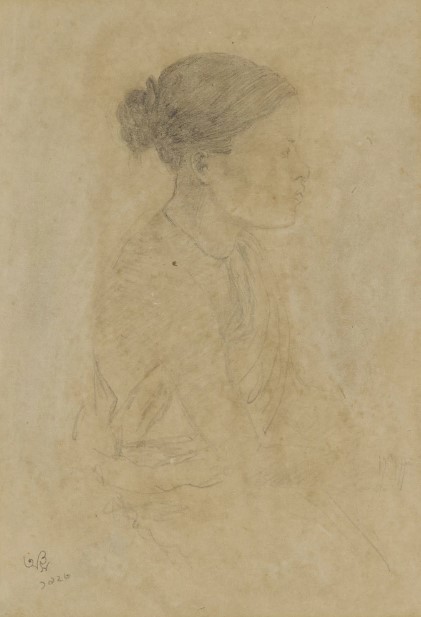 Asit Kumar Haldar, Untitled, Https://Www.Sothebys.Com/
Asit Kumar Haldar, Untitled, Https://Www.Sothebys.Com/
Role of Rabindranath Tagore and Santiniketan School in Bengal Renaissance
Tagore was a pivotal figure in the Bengal Renaissance, blending traditional and modern components while opposing imperialism and irrational patriotism. He constituted the last phase of the Bengal Renaissance, whose goal was to ensure a secular battle for logical freethinking. The art school, established in Santiniketan, was deeply associated with poet and polymath Rabindranath Tagore, who encouraged and actively engaged in the movement. His concept of art and education at Santiniketan affected the institution’s culture and the artistic journey of the artists studying there. The art School in rural town highlighted a comprehensive approach to education and art, blending art with nature and daily life. Artists such as Nandalal Bose, Ramkinkar Baij, and Benode Behari Mukherjee made major contributions to the development of contemporary Indian art.
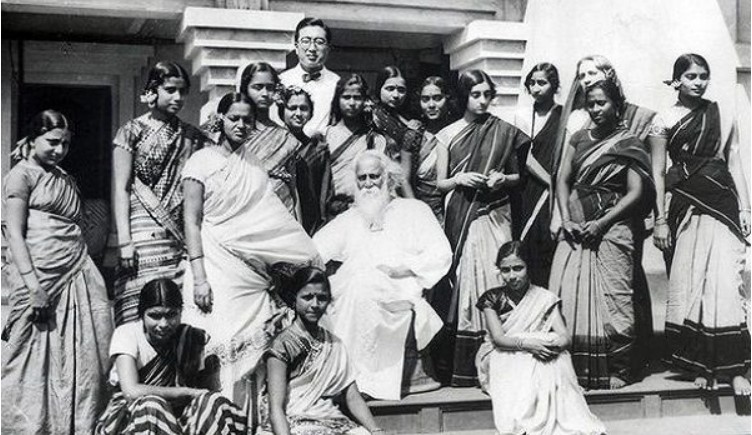 Rabindranath Tagore with his Pupil at Visva Bharati University, Santiniketan, https://www.differenttruths.com/
Rabindranath Tagore with his Pupil at Visva Bharati University, Santiniketan, https://www.differenttruths.com/
Unique Features of Bengal School of Painting
The artistic style of Bengal School painters stands out for many unique qualities that they inculcated, as follows:
- Emphasis on Indian style of painting: Bengal School promoted the indigenous and nationalistic art identity. The artists discarded Western academic art and instead were inclined towards Indian cultural and artistic heritage portraying themes from Indian mythology, epics and history.
- Reviving Traditional Techniques: The Bengal School painters were instrumental in maintaining and revitalizing ancient Indian art techniques such as tempera painting and natural dyes, which were on the verge of extinction. They experimented with these approaches, which were influenced by ancient Indian art traditions, in contrast with contemporary movements like the Calcutta Group and the Society of Contemporary Artists, which concentrated on novel and novel approaches.
- Amalgamation of Modern and Traditional: The Bengal School was effective in fusing traditional Indian aesthetics with contemporary art principles. The artists included elements from Mughal and Rajput miniature paintings, as well as Ajanta cave murals, into their works, but altered them for a more contemporary aesthetic environment.
- Nationalist Art: The Bengal School painters’ works were driven by a deeper purpose rather than merely making aesthetically beautiful art. They thought that by teaching pride in Indian culture, tradition, and history, their work might help the Indian nationalist movement
- Social Reform through art: The Bengal School painters saw art as a vehicle to effect social and cultural change. They saw their artistic pursuits as a means of reclaiming India’s cultural independence from colonial influences.
- Symbolism and stabilization: Bengal School painters developed a distinct style characterized by stylized shapes and flat perspectives, frequently revealing deeper ideas through visual representation. This approach was in sharp contrast to the Calcutta Group and Society of Contemporary Artists, which stressed individual expression and experimentation, resulting in a broader diversity of creative forms.
The Bengal School of Art was an important Indian art movement that sought to develop an original Indian art style at an age of Western influence. It was a pivotal movement in Indian art history because it emphasized patriotic themes, restored old methods, and mixed modern and traditional aspects. The school was associated with the visionary thinker Rabindranath Tagore, and it played an important role in developing contemporary Indian art and fostering a unique creative identity through enormous social and political developments.
Other Contemporary Art Movements in Bengal
Several Modern Art movements evolved in response to the Bengal Renaissance during the Bengal School of Art, exhibiting distinct approaches to art and aesthetics. The Calcutta Group, founded in 1943, aspired to promote Modern Art and break free from the influence of the Bengal School. Pradosh Dasgupta, Gopal Ghose, and Paritosh Sen were among the key members. The Society of Contemporary Artists, founded in 1947, provided a venue for artists to exhibit their contemporary and experimental works. Together with the Bengal School, these movements contributed to the development of contemporary Indian art by broadening the aesthetic scene, stimulating experimentation, and laying the framework for regional art movements throughout India. Each movement provided a distinct viewpoint on the cultural fabric of Indian art during the twentieth century.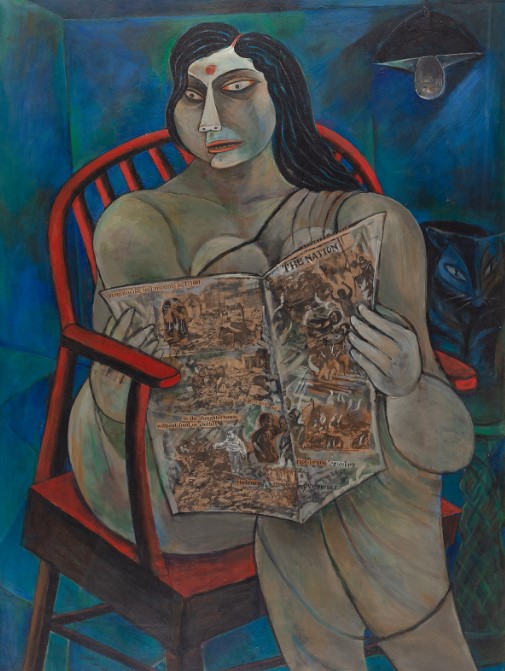
Woman reading a newspaper, Acrylic on Canvas, Paritosh Sen, In collection: DAG,https://dagworld.com/
Conclusion
The Bengal Renaissance was a pivotal period in Indian history that produced a number of noteworthy personalities that transformed the country’s cultural, social, and political landscape. Their vision, intellectual interests, and dedication to progress continue to inspire India’s future as a dynamic and diverse nation in the twenty-first century. The Bengal Renaissance heritage is a significant part of India’s identity, demonstrating the power of ideas and social reform in shaping a nation’s destiny. The Bengal Renaissance’s beliefs and principles affected India’s social and political structure as well as the arts, most prominently in the Bengal region including present-day Bangladesh and West Bengal. The trends formed by the Bengal Renaissance emerged into important artistic reforms in the Bengal region, such as institutions like ‘The Indian Society of Oriental Arts’ and ‘Bengal School’ art movement, which highly contributed to the artistic history of Bengal and India. The arts flourished throughout the Renaissance period, with artists like Abanindranath Tagore and Nandalal Bose leading the way in the Bengal School of Art. Their innovative styles and techniques continue to influence today’s artists. The legacy of the Bengal Renaissance lives on in the inclusive and diverse culture, in both India and neighbouring Bangladesh, which share cultural heritage from the undivided past.
References
- Anandita Mondal, 2020, “Bengal Renaissance: A theoretical Analysis”, Journal of Critical Reviews, Vol.7., Issue 10, pp. 6523-6534, ISSN: 2394-5125.
- Eva Sarah Molcard, 1st March 2019, “How the Bengal School of Art gave rise to Indian Nationalism’, Indian & South Asian Contemporary Art, Sotheby’s,
- Aseem Asha Usman, 8th May 2018, “Revisiting the Bengali Renaissance through the eyes of Tagore”, Different Truths
- “Influence of Renaissance on Bengali Paintings”, Indian Net-zone
Read Also:
Abanindranath Tagore: A Painter of Bharat Mata and Founder of Bengal School

Contributor

